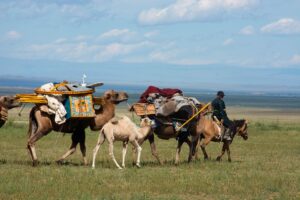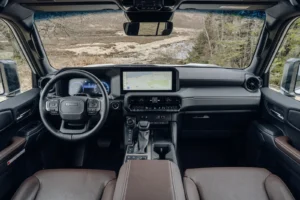Introduction: The Living Desert
Наблюдение за дикой природой в пустыне Гоби Монголия: Когда путешественники слышат это слово Gobi Desert, many picture an endless emptiness of sand dunes stretching to the horizon. Yet, this stereotype could not be further from the truth. The Gobi Desert of Mongolia is one of the most diverse and wildlife-rich ecosystems on Earth. It is not a lifeless void, but a vast realm of steppes, rocky mountains, desert plains, oases, salt pans, and rolling dunes. This is the land where the wild Bactrian camel still roams, where the elusive snow leopard stalks ibex on jagged cliffs, and where thousands of Mongolian gazelles thunder across the grasslandsduring their seasonal migrations.
Протянувшаяся от восточной степи провинции Сухэ-Батор до горной пустыни провинции Ховд на крайнем западе, Гоби - это не просто пустыня, а живой музей эволюционной устойчивости. Животные здесь приспособились выживать в экстремальных условиях палящего лета, морозной зимы и нехватки воды. Для путешественников Гоби предлагает одни из самых редких в мире встреч с дикой природой: увидеть антилопу сайгака, находящуюся под угрозой исчезновения, понаблюдать за бородатым стервятником, сбрасывающим кости с неба, или отследить следы медведя Гоби (Мазаалаи) - вида, насчитывающего менее 50 особей.
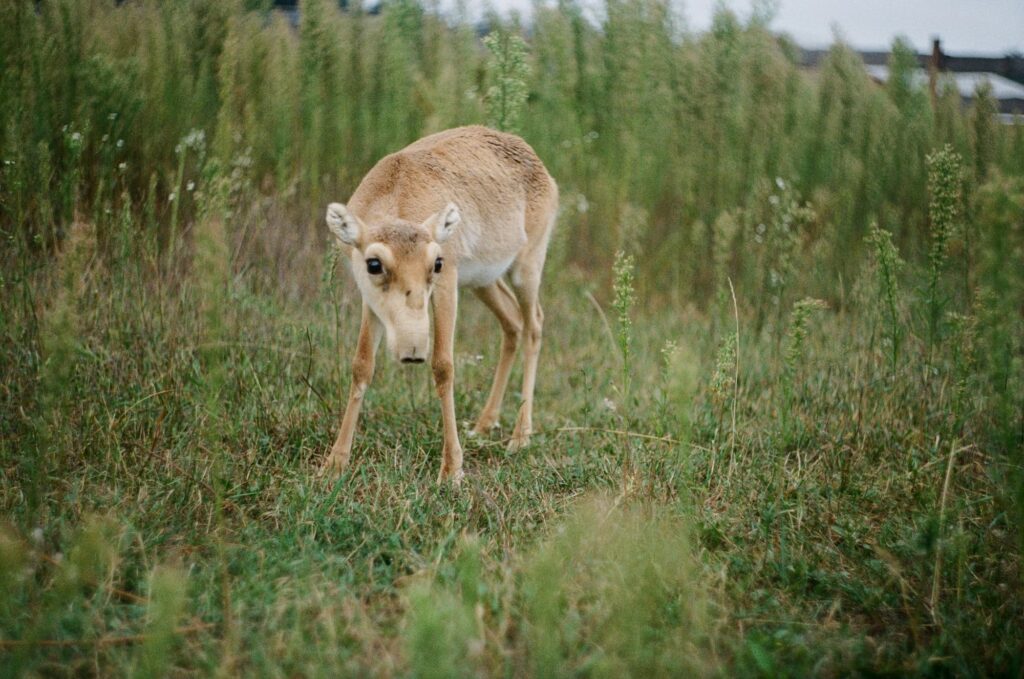
Для тех, кто готов отправиться в путешествие вдали от асфальтированных дорог, Гоби становится сафари в дикой природе, не похожим ни на одно другое. В отличие от жестко управляемых национальных парков Африки, Гоби - это земля необузданной свободы. Чтобы исследовать самые дальние уголки пустыни, вам понадобится надежный прокат 4×4 в Монголии, такой как прочный Toyota Land Cruiser, предоставляемый Gobi.Rent. С палаткой на крыше, GPS и запасом топлива вы сможете самостоятельно проехать через эту дикую границу и увидеть дикую природу Монголии в ее естественной среде обитания.
В этом исчерпывающем путеводителе вы пройдете провинцию за провинцией, с востока на запад, подробно узнаете, какие животные где обитают, как их увидеть, в какое время года лучше всего приезжать и какие места обитания исследовать. Это не просто статья о путешествии - это ваше полевое руководство по наблюдению за дикой природой в пустыне Гоби.
К концу путешествия вы поймете, почему Гоби - это не бесплодная пустошь, а один из последних великих рубежей дикой природы на Земле.
Chapter 1: The Habitats of the Gobi Desert
Прежде чем перейти к рассмотрению конкретных провинций и животных, необходимо понять разнообразие среды обитания пустыни Гоби. В отличие от песчаной картины, которую представляют себе люди со стороны, Гоби - это целая сеть экосистем. Каждая среда обитания поддерживает различные виды, и знание этих сред поможет вам понять, где искать животных, которых вы ищете.
1.1 The Eastern Steppe (Sukhbaatar & Dornogovi)
Восточная Гобийская степь - это обширный, открытый ландшафт лугов, переходящих в полупустынные равнины. Это царство монгольской газели, одного из крупнейших оставшихся на Земле мигрирующих стад диких копытных. Газели передвигаются стадами в десятки тысяч, преследуемые волками и беркутами. В восточной части Гоби также обитают корсак-лиса и широкий спектр мелких грызунов и хищных птиц.
- Best time to visit: Spring and autumn, during gazelle migrations.
- Key animals: Mongolian gazelle, steppe wolf, corsac fox, saker falcon.
1.2 Semi-Desert Plains (Dundgovi & Ömnögovi)
По мере продвижения на запад трава становится все более редкой, а на горизонте появляются каменистые равнины. Это зона полупустыни, где вода становится все скуднее, а выживают только самые выносливые животные. Волки все еще бродят здесь, а хищники, такие как степные орлы и беркуты, патрулируют небо. В этих ландшафтах можно встретить и редкого манула - неуловимого дикого кота, прекрасно приспособленного к обитанию в скалистых норах.
- Best time to visit: Autumn and spring.
- Key animals: Wolves, Pallas’s cat, steppe eagle, golden eagle.
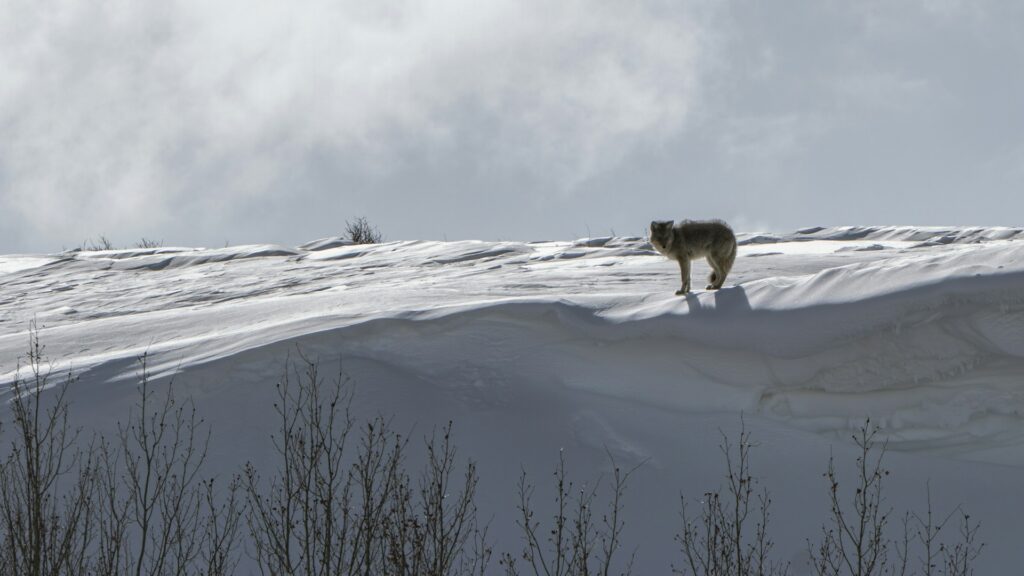
1.3 The True Desert (Ömnögovi)
В самом сердце Гоби находится настоящая пустыня, с гигантскими песчаными дюнами, гравийными равнинами и солончаками. В этой суровой среде обитают гобийский медведь (мазалай) и дикий бактрийский верблюд, два самых редких крупных млекопитающих на Земле. Чтобы увидеть их, необходимо отправиться в Строго охраняемую зону Великой Гоби, одну из наименее нарушенных пустынь на планете.
- Best time to visit: Summer for bears, spring/autumn for camels.
- Key animals: Gobi bear, wild Bactrian camel, desert reptiles.
1.4 Mountain Habitats (Ömnögovi, Govi-Altai, Khovd)
Из равнин внезапно поднимаются труднопроходимые горные хребты, такие как Тостские горы и Алтайский хребет. Эти скалы и хребты - оплот снежных барсов, сибирских горных козлов и аргалинских баранов. Вертикальный рельеф предоставляет убежище как для хищников, так и для добычи. Здесь также часто встречаются хищники, такие как ламмергейер.
- Best time to visit: Winter and early spring for snow leopards; year-round for ibex and argali.
- Key animals: Snow leopard, Siberian ibex, argali sheep, lammergeier.
1.5 Lakes and Oases (Bayankhongor, Khovd)
Хотя Гоби сухая, здесь есть озера и реки, особенно в западных районах. <Озеро Орог, озеро Таацин Цагаан и озеро Хар Ус являются магнитом для перелетных птиц. Здесь собираются журавли, гуси, утки и даже редкие дрофы, что делает эти водно-болотные угодья важнейшими местами наблюдения за птицами.
- Best time to visit: May–June for nesting, August–September for migration.
- Key animals: Migratory cranes, geese, ducks, sandgrouse, Houbara bustard.
<Краткое содержание главы 1:
Пустыня Гоби - это не один ландшафт, а множество: открытая степь, полупустынные равнины, настоящая пустыня, труднопроходимые горы и сезонные болота. Каждый из них представляет собой уникальную среду обитания, и о каждом из них пойдет речь в последующих главах о дикой природе. Понимание этих зон позволит вам стратегически грамотно спланировать свое путешествие, обеспечив наилучшие шансы встретить редких животных пустыни Гоби в Монголии.
Chapter 2: Eastern Gobi Wildlife – Sukhbaatar & Dornogovi
Восточная пустыня Гоби, охватывающая провинции Сухэ-Батор и Дорногови, - одна из самых динамичных зон дикой природы в Монголии. В отличие от бесплодных стереотипов о пустынях, этот регион представляет собой обширную экосистему степей и пустынь. Здесь до самого горизонта простираются широкие равнины, усеянные кустарниками и сухими травами, что создает идеальные пастбища для монгольских газелей. Восточная Гоби также является важным местом охоты для волков, хищников и корсаков.
Для любителей дикой природы восточные районы Монголии являются одними из самых доступных мест для наблюдения за дикими животными, благодаря огромному количеству животных, особенно стад монгольских газелей.
2.1 The Mongolian Gazelle (Procapra gutturosa)
Where to See Them
Монгольская газель - звезда Восточной Гоби. Их стада могут исчисляться десятками тысяч, что делает их одним из последних крупных мигрирующих копытных животных, оставшихся в Азии. Их можно встретить в основном в провинции Сухэ-Батор, а в зависимости от наличия травы они перемещаются на запад, в Дорногови.
When to Spot Them
- Spring (April–June): Calving season, when females gather in large groups.
- Autumn (Sept–Oct): Migration peaks, creating massive moving herds.
- Best Times of Day: Dawn and dusk, when gazelles graze actively.
How to Spot Them
Ищите на горизонте пылевые облака - верный признак движущихся стад. Обязательно возьмите бинокль, поскольку газели пугливы и будут держаться на расстоянии от автомобилей. При раннем утреннем свете их загорелые шерстинки сливаются с лугами, поэтому терпение и сканирование - ключевые факторы.
Fun Fact
Монгольские газели могут развивать скорость до 65 км/ч, а когда их пугают, целые стада скачут вместе в захватывающий унисон.
Читайте, если вам интересны: Монгольская миграция джейранов, джейраны Сухэ-Батора, стада джейранов Дорногови, наблюдение за джейранами Монголии.
2.2 Corsac Fox (Vulpes corsac)
Where to See Them
Лисица-корсак процветает на полупустынных равнинах Дорногови и открытых лугах Сухэ-Батора. В отличие от рыжей лисицы, корсак меньше, а его бледно-песочный мех отлично маскируется на фоне степи Гоби.
When to Spot Them
- Best Season: Autumn and winter, when coats grow thick and pale.
- Best Time of Day: Dawn and dusk, when foxes hunt for rodents and hares.
How to Spot Them
Ищите вблизи колоний грызунов, особенно норы сурков или песчанок. Лисиц часто можно заметить рыскающими по открытым равнинам. Используйте бинокль, чтобы засечь их, когда они сидят прямо и сканируют горизонт.
Behavior
Corsac foxes are opportunistic hunters, often following herds to scavenge. At night, they emit high-pitched barks that carry across the steppe.
Читайте это, если вам интересно: корсак лиса Монголия, лисы в Дорногови, лиса пустыни Гоби, дикая природа в восточной Гоби.
2.3 The Steppe Wolf
Where to See Them
Степной волк следует за стадами джейранов по всей провинции Сухэ-Батор. Эти волки крупнее корсака и являются верховными хищниками в экосистеме Восточной Гоби.
When to Spot Them
- Best Season: Year-round, but especially spring and autumn during gazelle migrations.
- Best Time of Day: Dawn, when wolves patrol the edges of herds.
How to Spot Them
Scan areas where gazelle herds are resting. Wolves are skilled at using terrain for cover, so look for movement near small rises or dry riverbeds. Tracks and scat are often found near watering holes.
Behavior
Wolves hunt in packs and can bring down adult gazelles. They are also scavengers, feeding on carcasses left behind by eagles or foxes.
Read this if you are interested in: steppe wolf Mongolia, wolves in Sukhbaatar, Gobi Desert predators, wolf spotting Mongolia.
2.4 Raptors of the Eastern Gobi
Небо над Сухэ-Батором и Дорногови патрулируют рапторы, что делает этот регион раем для любителей птиц.
Steppe Eagle (Aquila nipalensis)
- Where: Open plains, nesting on the ground or low cliffs.
- When: Spring and autumn migrations.
- How to Spot: Circling on thermals at midday, scanning for rodents.
Saker Falcon (Falco cherrug)
- Where: Dornogovi cliffs and semi-desert plains.
- Status: National bird of Mongolia, highly prized in falconry.
- How to Spot: Fast-flying falcon hunting ground squirrels and pigeons.
Golden Eagle (Aquila chrysaetos)
- Where: Cliff ranges and hilly zones in Sukhbaatar.
- How to Spot: Huge wingspan, soaring in pairs.
Read this if you are interested in: raptors in Gobi Desert, steppe eagle Mongolia, saker falcon spotting, Dornogovi birdwatching.
2.5 Small Mammals & Steppe Rodents
Степь Восточной Гоби живет мелкими млекопитающими. Хотя они не так привлекательны, но составляют основу пищевой цепи.
- Marmots: Though more common in northern steppes, colonies exist in Sukhbaatar. Look for burrow mounds.
- Gerbils & Jerboas: Nocturnal rodents seen at night with a torch.
- Tolai Hare: Pale desert hare, often flushed from shrubs.
These small creatures attract foxes, wolves, and raptors, making them essential for spotting larger predators.
Read this if you are interested in: rodents in Gobi Desert, jerboa Mongolia, marmots Sukhbaatar, steppe wildlife Mongolia.
Tips for Wildlife Spotting in Eastern Gobi
- Best Provinces: Sukhbaatar for gazelles, Dornogovi for raptors and foxes.
- Best Season: April–June and September–October.
- Best Gear: Binoculars, spotting scope, and GPS navigation.
- Best Vehicle: Rent a 4×4 from Gobi.Rent — eastern tracks can be sandy and remote.
- Camping Tip: Stay near dry riverbeds for nighttime fox calls and dawn birdwatching.
Why the Eastern Gobi Matters
Восточная степь Гоби - одно из последних мест на Земле, где до сих пор происходят массовые миграции копытных. Стада монгольских джейранов соперничают с африканскими миграциями диких козлов, однако их наблюдает гораздо меньше путешественников. Защита этой экосистемы жизненно важна не только для джейранов, но и для волков, хищников и лисиц, которые от них зависят.
Для путешественников восток является идеальной отправной точкой для сафари по пустыне Гоби. Отсюда путешествие можно продолжить на запад, в центральную часть пустыни, где пейзажи и дикая природа становятся еще более впечатляющими.
Chapter 3: Central Gobi Wildlife – Dundgovi & Ömnögovi
Когда путешественники думают о пустыне Гоби, они обычно представляют себе сердце пустыни - бескрайние просторы провинции Дундгови и легендарные дюны и горы провинции Цмногови. Это ядро Гоби, место знаковых пейзажей: возвышающихся песчаных дюн, скалистых каньонов, скрытых оазисов и священных гор.
Но помимо пейзажей, Центральная Гоби является домом для некоторых из самых редких и исчезающих видов животных в мире. В этом регионе обитают гобийский медведь (мазалай), неуловимый дикий бактрийский верблюд, стада аргальских овец и ибексов, а также такие хищники, как снежный барс. Для любителей дикой природы Дундгови и Омнегови являются жемчужиной сафари по пустыне Гоби.
3.1 Gobi Bear (Mazaalai)
Status
- Осталось менее 60 особей, что делает Гобийского медведя одним из самых редких животных на Земле.
- Находится под критической угрозой исчезновения и встречается только в Монголии.
Where to See Them
Гобийский медведь обитает в строго охраняемой зоне А Великой Гоби, в основном в провинции Цмнэгови. Их среда обитания - оазисы и пустынные источники, разбросанные по этой отдаленной пустыне.
When to Spot Them
- Best Season: Summer (July–August), when they come to water sources.
- Time of Day: Early morning and dusk, when temperatures are cooler.
How to Spot Them
Чтобы увидеть Мазаалаи, требуется терпение и зачастую помощь местных егерей. Они часто встречаются вблизи водоемов, например в оазисе Эхийн-Гол. Ищите следы на песке и следы когтей на скальных выступах.
Read this if you are interested in: Gobi bear, Mazaalai Mongolia, rarest bear species, Gobi Desert endangered animals.
3.2 Wild Bactrian Camel (Camelus ferus)
Status
- В Гоби выжило менее 1 000 диких верблюдов, поэтому они находятся под критической угрозой исчезновения.
- Different from domestic camels: slimmer build, smaller humps, and remarkable adaptations to saltwater.
Where to See Them
Дикие верблюды бродят по пустынной степи Гоби в Омнегови и некоторых частях Дундгови, часто вблизи сухих русел рек и соленых источников.
When to Spot Them
- Best Season: Autumn (Sept–Oct), during migrations between pastures.
- Best Time: Early mornings, as they graze in small herds.
How to Spot Them
They are extremely wary of humans. Use binoculars to scan for movement at the base of sand dunes or along dry valleys. Unlike domestic herds, wild camels keep their distance and move quickly away from vehicles.
Read this if you are interested in: wild Bactrian camel Mongolia, Ömnögovi wildlife, endangered camels Gobi Desert.
3.3 Argali Sheep & Siberian Ibex
На горных хребтах Дундгови и Омнегови обитают два самых легендарных копытных животных Монголии:
- Argali Sheep (Ovis ammon): The world’s largest wild sheep, with massive spiraled horns.
- Siberian Ibex (Capra sibirica): Agile climbers, often found on cliffs and rocky gorges.
Where to See Them
- Аргалийских овец лучше всего наблюдать в горах Их Богд в Дундгови.
- В ущелье Йолын-Ам и на скалах гор Трех красавиц (Национальный парк Гурван-Сайхан) в Омнегови распространены горные козлы.
Best Season & Time
- Spring & Autumn: Mating seasons increase visibility.
- Dawn: Herds descend to graze.
How to Spot Them
Use spotting scopes to scan cliffsides at sunrise. Argali rams stand out by their massive horns, while ibex move in herds across steep terrain.
Read this if you are interested in: argali sheep Mongolia, ibex in Gobi Desert, Dundgovi mountain wildlife, Gurvan Saikhan National Park animals.
3.4 Snow Leopard (Panthera uncia)
Призрак гор, снежный барс, бродит по высоким хребтам Центральной Гоби. Хотя встречи с ними невероятно редки, осознание того, что они делят ландшафт, придает региону ощущение волшебства.
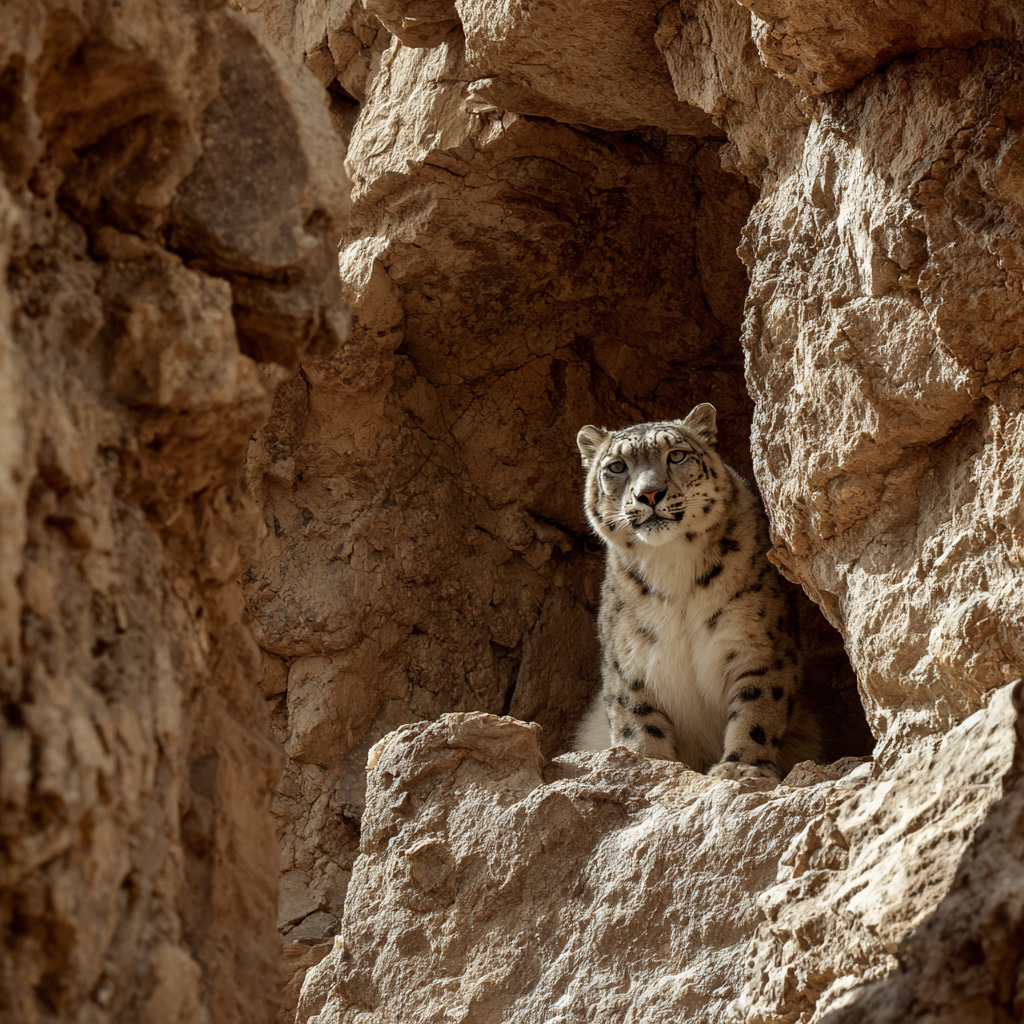
Where to See Them
- Gurvan Saikhan Mountains, Ömnögovi
- Ikh Bogd range, Dundgovi
Best Season & Time
- Winter (Nov–Feb): Snow leopards descend to lower altitudes following ibex and argali.
- Dawn & Dusk: Prime hunting hours.
How to Spot Them
Spotting snow leopards in the wild requires joining conservation-led tracking tours. Look for fresh scat, paw prints in snow, or the alarm calls of ibex.
Read this if you are interested in: snow leopard Mongolia, snow leopard in Gobi Desert, Central Gobi predators, wildlife tracking Mongolia.
3.5 Raptors & Birds
Скалы и долины Центральной Гоби - идеальная среда обитания для хищников и редких пустынных птиц.
- Lammergeier (Bearded Vulture): Seen soaring in Yolyn Am gorge. Famous for bone-dropping behavior.
- Steppe Eagle & Golden Eagle: Patrol the open valleys.
- Desert Finch & Saxaul Sparrow: Small birds adapted to desert shrubs.
- Houbara Bustard: Rare ground bird, spotted in remote steppe zones.
Read this if you are interested in: birdwatching in Gobi Desert, Lammergeier Mongolia, Gurvan Saikhan birds, Ömnögovi bird species.
3.6 Other Mammals of Central Gobi
- Red Fox & Corsac Fox: Common across steppe regions.
- Pallas’s Cat (Manul): Elusive wildcat found in rocky habitats. Best seen at dawn.
- Wolves: Predators that follow gazelles and argali herds.
These smaller predators make the ecosystem balanced, feeding on rodents and scavenging from larger kills.
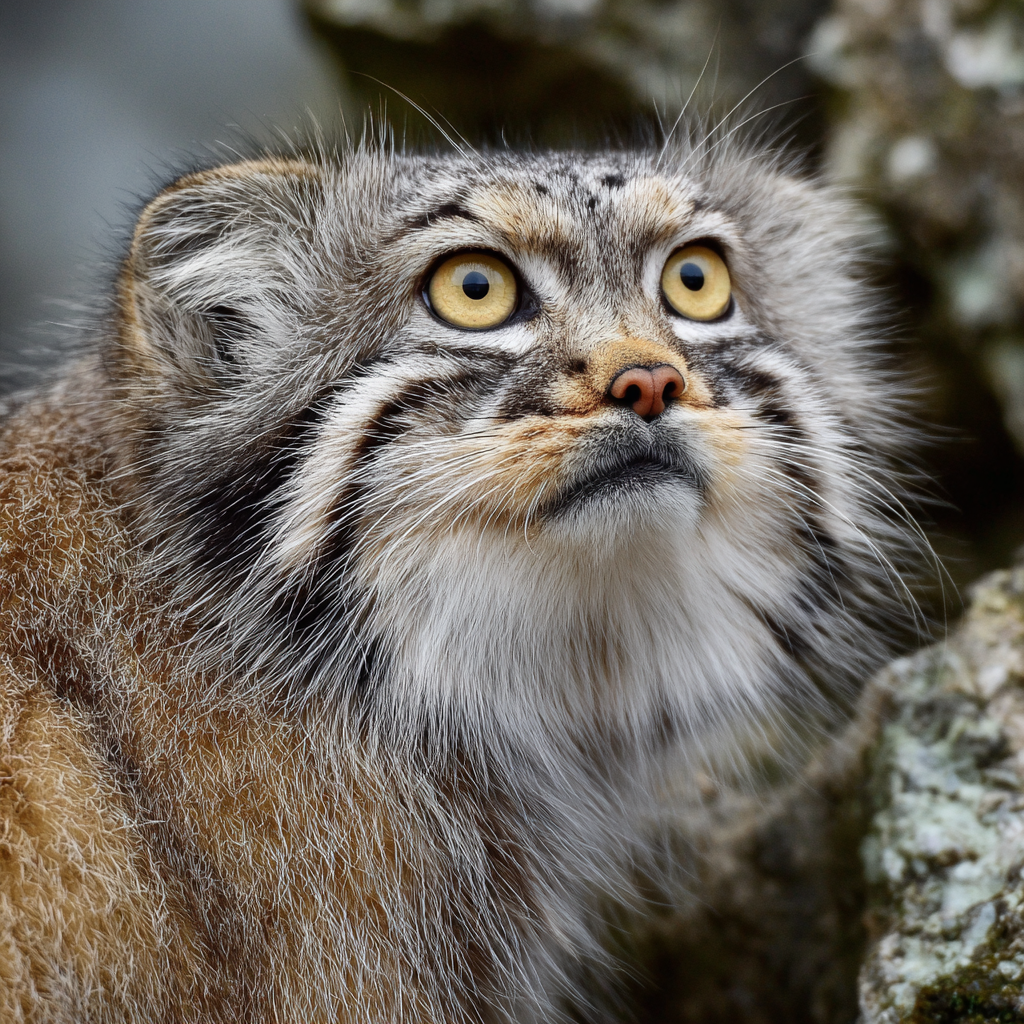
Read this if you are interested in: wolves in Ömnögovi, Pallas’s cat Gobi, fox species Mongolia.
Tips for Wildlife Spotting in Central Gobi
- Best Provinces: Ömnögovi (Gurvan Saikhan, Yolyn Am, Khongoryn Els dunes), Dundgovi (Ikh Bogd mountains).
- Best Seasons: Summer for Gobi bears, autumn for camels, winter for snow leopards.
- Best Gear: Spotting scope, long-lens camera, GPS, desert survival kit.
- Best Vehicle: A Toyota Land Cruiser 78 or 79 rented from Gobi.Rent, equipped for rough desert roads.
- Camping Tip: Stay near natural springs and canyons — they attract wildlife at dawn and dusk.
Why Central Gobi Matters
Пустыня Центральная Гоби - это сердце дикой природы Монголии. Здесь обитают самые редкие животные, включая находящегося под угрозой исчезновения гобийского медведя и дикого бактрийского верблюда. Без этой пустыни эти виды исчезли бы навсегда.
Для путешественников Центральная Гоби предлагает единственный в жизни опыт сафари - увидеть диких верблюдов, идущих по дюнам, горных козлов, сидящих на скалах, и, возможно, тень снежного барса.
Chapter 4: Western Gobi Wildlife – Bayankhongor, Govi-Altai & Khovd
Западная пустыня Гоби - это место, где равнины Монголии сливаются с горной системой Алтая. Это создает впечатляющую смесь сред обитания: пустыни, полупустынные степи, изрезанные скалы, альпийские зоны, соленые озера и речные долины. В этих ландшафтах обитает множество приспособленных к горным условиям видов - от антилоп сайгаков Шаргинской Гоби до аргальских баранов и ибексов на скалистых склонах и парящих ламмергеров в высоких утесах.
Западные провинции - Баянхонгор, Гови-Алтай и Ховд - самые отдаленные участки пустыни Гоби. Дикая природа здесь неуловима, но вознаграждает терпеливых путешественников, которые отправляются в путь, имея подходящее снаряжение и транспортные средства.
4.1 Saiga Antelope (Saiga tatarica mongolica)
Status
- Critically endangered. The Mongolian subspecies has declined drastically due to poaching and habitat loss.
- Знамениты своим пухлым носом, который фильтрует пыль летом и согревает воздух зимой.
Where to See Them
- Shargiin Gobi, Khovd province.
- Open steppe zones with sparse vegetation.
Best Season & Time
- Winter (Nov–Feb): Tracks are more visible in snow.
- Early Morning: Herds graze openly.
How to Spot Them
Присоединяйтесь к экскурсиям по окрестностям Шарджин-Гоби. Ищите следы на снегу или в пыли и сканируйте их с помощью бинокля на расстоянии. Сайгаки очень пугливы и быстро убегают, если их потревожить.
Read this if you are interested in: saiga antelope Mongolia, Shargiin Gobi wildlife, endangered antelope Gobi Desert.
4.2 Siberian Ibex & Argali Sheep
На скалистых хребтах западной Гоби, подверженной влиянию Алтая, процветают два легендарных копытных.
- Siberian Ibex (Capra sibirica): Recognizable by their long, curved horns.
- Argali Sheep (Ovis ammon): The world’s largest wild sheep, with horns weighing up to 20 kg.
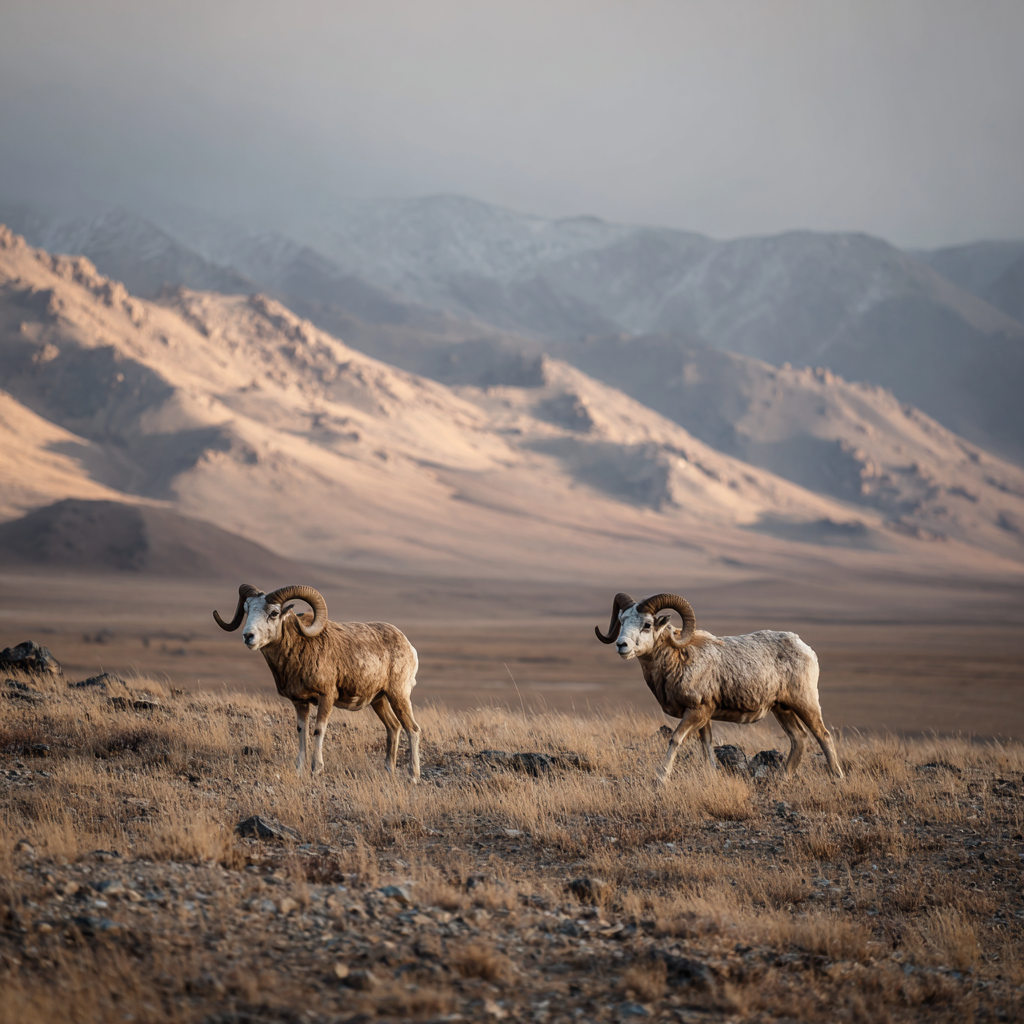
Where to See Them
- Mountains of Govi-Altai and Khovd provinces.
- Cliffs and steep slopes near alpine meadows.
Best Season & Time
- Spring & Autumn: Herds gather in visible groups.
- Sunrise: Best chance, as they descend to feed.
How to Spot Them
Use spotting scopes to watch from a distance. Look for movement high on cliffs. Often ibex are seen in herds, while male argali can be spotted in bachelor groups.
Read this if you are interested in: argali sheep Gobi Altai, Siberian ibex Mongolia, mountain wildlife Khovd, Govi-Altai animals.
4.3 Lammergeier (Bearded Vulture)
Гламмергейер, или бородатый гриф, - одна из самых впечатляющих птиц Гоби-Алтайских скал.
Where to See Them
- Скалы и ущелья Гови-Алтайской области.
- Часто встречается вблизи ареалов аргали и горных козлов, где они собирают кости.
Unique Behavior
- Знаменит тем, что носил кости высоко в воздух и сбрасывал их на камни, чтобы расколоть.
- Feeds almost entirely on bone marrow.
Best Season & Time
- Круглогодичный житель Алтайских хребтов.
- Best spotted at midday, soaring in thermals.
Read this if you are interested in: lammergeier Mongolia, bearded vulture Gobi Altai, raptors of the Gobi Desert.
4.4 Other Mammals of the Western Gobi
- Wolves (Canis lupus): Common in Bayankhongor province, hunting gazelles and livestock. Best seen in early morning on open steppe.
- Pallas’s Cat (Manul): Elusive wildcat of rocky steppe habitats in Khovd. Best spotted at dawn or dusk.
- Corsac Fox: A small desert fox active in twilight, often near saiga ranges.
Read this if you are interested in: wolves in Bayankhongor, Pallas’s cat Mongolia, Corsac fox Gobi Desert.
4.5 Rare & Migratory Birds
Western Gobi lakes and valleys are important stopovers for migratory birds.
- Cranes (Demoiselle & Siberian Cranes): Seen at Khar Us Lake and Orog Lake.
- Saker Falcon (Falco cherrug): Mongolia’s national bird, often spotted hunting across steppes.
- Steppe Eagle & Golden Eagle: Regular in Govi-Altai.
Read this if you are interested in: birdwatching Khovd Mongolia, cranes in Gobi Desert, Saker Falcon Mongolia, Orog Lake birds.
4.6 Seasonal Patterns in Western Gobi
- Winter: Best time for saiga spotting. Snow makes tracking easier.
- Spring: Raptors nesting in cliffs, ibex active.
- Summer: Wolves near water sources; Pallas’s cat sometimes spotted.
- Autumn: Argali rams engage in head-butting contests.
Tips for Wildlife Spotting in Western Gobi
- Provinces to Visit:
- Bayankhongor: Wolves, migratory birds at Orog Lake.
- Govi-Altai: Ibex, argali, lammergeiers in rocky mountains.
- Khovd: Saiga antelope in Shargiin Gobi, Pallas’s cat in steppe.
- Travel Style:
- Воспользуйтесь Toyota Land Cruiser 79 с тентом на крыше от Gobi.Rent.
- Western Gobi roads are extremely rough — self-drive safaris need well-equipped vehicles.
- Best Seasons:
- Winter for saiga, snow leopards lower down.
- Spring for ibex and argali.
- Spotting Techniques:
- Always carry binoculars and a spotting scope.
- Scan ridge lines at dawn.
- Stay quiet and observe from afar to avoid scaring animals.
Why the Western Gobi is Special
В Западной Гоби пустыня сочетается с алтайскими горными экосистемами, создавая оплот для критически исчезающих животных, таких как антилопа сайгак и редкие хищники, такие как манул.
Для любителей дикой природы это один из последних истинных рубежей природы - отдаленный, дикий и захватывающий дух. Немногие путешественники добираются сюда, но те, кому это удается, становятся свидетелями той стороны Монголии, которая кажется нетронутой временем.
Chapter 5: Birds of the Gobi – An Underrated Paradise for Birdwatching
Пустыня Гоби на первый взгляд может показаться бесплодной, но на самом деле это одно из самых недооцененных мест для наблюдения за птицами в Азии. Ее уникальные экосистемы - скалистые ущелья, саксауловые леса, песчаные дюны, степные озера и пустынные оазисы - привлекают более 200 видов птиц, в том числе перелетных, хищных и пустынных, не встречающихся больше нигде в мире.
Любителям птиц и дикой природы Гоби предлагает возможность увидеть ламмергеров, роняющих кости, журавлей, танцующих у пустынных озер, и соколов, охотящихся над бескрайней степью. Где бы вы ни находились - в Сухэ-Баторе на востоке или в Ховде на западе, - в каждой провинции пустыни Гоби можно увидеть разные пернатые достопримечательности.
5.1 Lammergeier (Bearded Vulture)
- Where: Common in the cliffs of Govi-Altai, Ömnögovi, and Dundgovi provinces.
- Behavior: Famous for dropping bones from the sky to break them open and eat the marrow.
- Best Time: Midday, when thermals allow soaring flight.
- Habitat: High cliffs and mountain valleys.
Read this if you are interested in: lammergeier Mongolia, bearded vulture Gobi Desert, raptors of Mongolia.
5.2 Golden Eagle & Steppe Eagle
Golden Eagle (Aquila chrysaetos)
- Символ силы, используемый в традиционной охоте на орла в Западной Монголии.
- Where: Cliffs and ridges across the Gobi Altai.
- When: Year-round, especially visible in winter.
Steppe Eagle (Aquila nipalensis)
- Migratory raptor traveling thousands of kilometers between Mongolia and Africa.
- Where: Open steppe zones in Dornogovi, Dundgovi, and Ömnögovi provinces.
- When: Spring and autumn migrations (April–May, Sept–Oct).
Read this if you are interested in: golden eagle Gobi, steppe eagle migration Mongolia, raptors in Gobi Desert.
5.3 Saker Falcon – Mongolia’s National Bird
- Status: Endangered due to habitat loss and trapping.
- Where: Steppes and semi-desert zones of Dornogovi and Ömnögovi provinces.
- Behavior: Hunts pigeons, ground squirrels, and small birds in fast aerial dives.
- Best Season: Spring and summer (April–July), during breeding season.
Read this if you are interested in: Saker Falcon Mongolia, national bird of Mongolia, falcons of Gobi Desert.
5.4 Houbara Bustard (Chlamydotis undulata)
- Where: Remote desert steppe habitats of Ömnögovi and Govi-Altai.
- Status: Threatened by hunting and falconry across its range.
- Behavior: Ground-dwelling bird with elaborate courtship dances.
- Best Time: Spring (March–May), when males display.
Read this if you are interested in: Houbara Bustard Mongolia, rare desert birds, bustards Gobi Desert.
5.5 Sandgrouse
Several species of sandgrouse inhabit the Gobi Desert, perfectly adapted to dry conditions.
- Pallas’s Sandgrouse (Syrrhaptes paradoxus): Famous for carrying water in their belly feathers to chicks.
- Where: Open desert plains in Dornogovi and Dundgovi provinces.
- Best Time: Morning, when they fly in flocks to waterholes.
Read this if you are interested in: Pallas’s sandgrouse Mongolia, desert birds Gobi, sandgrouse water-carrying behavior.
5.6 Cranes of the Gobi
Cranes are among the most spectacular migratory birds of Mongolia, and several species use the Gobi’s lakes as stopovers.
- Demoiselle Crane: Common at lakes like Orog Lake (Bayankhongor) and Khar Us Lake (Khovd).
- White-Naped Crane: Threatened species, spotted in wetlands.
- Siberian Crane: One of the rarest cranes, occasionally sighted during migrations.
Best Seasons:
- May–June: Northward migration.
- August–September: Southward migration.
Read this if you are interested in: cranes in Mongolia, Demoiselle crane Gobi Desert, Orog Lake birdwatching.
5.7 Migratory Stopovers – Desert Lakes & Wetlands
Хотя Гоби - засушливый регион, его озера и водно-болотные угодья являются очагами биоразнообразия.
- Orog Lake (Bayankhongor): Migratory stopover for cranes, geese, and shorebirds.
- Khar Us Lake (Khovd): UNESCO Biosphere Reserve, hosting pelicans, ducks, and eagles.
- Boon Tsagaan Lake (Bayankhongor): Important for swans and migratory ducks.
Весной и осенью на этих озерах оживляется птичья жизнь, что делает их обязательными местами для посещения любителями наблюдать за птицами.
Read this if you are interested in: birdwatching Orog Lake, migratory birds Khar Us Lake, wetlands in Gobi Desert.
5.8 Small Desert Birds
В то время как хищники и журавли привлекают к себе внимание, маленькие птицы, обитающие в Гоби, не менее увлекательны.
- Saxaul Sparrow: Associated with saxaul forests in Dornogovi and Ömnögovi.
- Mongolian Ground Jay: Unique desert bird found in the central and western Gobi.
- Horned Lark: Widespread, often seen foraging in sandy valleys.
Read this if you are interested in: Saxaul Sparrow Mongolia, Mongolian Ground Jay, small desert birds Gobi.
5.9 Best Times for Birdwatching in the Gobi
- Spring (April–June): Bird nesting, raptor activity, crane migrations.
- Summer (July–August): Resident species active near waterholes.
- Autumn (Sept–Oct): Major southward migration of cranes, bustards, and raptors.
- Winter (Nov–Feb): Raptors like golden eagles and lammergeiers visible in snow landscapes.
Best Time of Day:
- Dawn: Birds emerge from roosts, raptors start hunting.
- Dusk: Sandgrouse and cranes return to water sources.
Why the Gobi is a Birdwatcher’s Dream
Несмотря на репутацию “безжизненной пустыни”, Гоби отличается биоразнообразием. Птицы Гоби - от костедробильного ламергейера до водоплавающей куропатки - демонстрируют одни из самых уникальных адаптаций в животном мире.
Для путешественников наблюдение за птицами в Гоби - это терпение и открытие. Тихое утро у пустынного озера или поход по скалистому ущелью могут открыть редкие и незабываемые виды. С помощью сафари-мобиля с автономным управлением от Gobi.Rent орнитологи могут добраться до отдаленных точек во всех провинциях пустыни.
Chapter 6: When and How to Spot Wildlife in the Gobi Desert
The Gobi Desert rewards patience, knowledge, and timing. Understanding when and how to spot wildlife makes the difference between a fleeting glimpse and an unforgettable encounter. Each season and each time of day reveals different species and behaviors.
Wildlife by Season in the Gobi Desert
Spring (April–June):
Spring is one of the best times to visit the Gobi Desert for wildlife spotting. Mongolian gazelle herds begin their migrations across Dornogovi and Sukhbaatar. This is also the season for bird nesting, with Houbara bustards displaying and cranes arriving at lakes like Orog and Boon Tsagaan. Mountain goats such as Siberian ibex are particularly active as they feed on fresh vegetation in Govi-Altai cliffs.
Summer (July–August):
Summer brings challenges with heat, but also rare opportunities. The endangered Gobi bear, or Mazaalai, can sometimes be seen near scarce water sources in Ömnögovi. Waterfowl concentrate around lakes in Bayankhongor and Khovd. Early mornings and late evenings are essential during this season, as midday heat keeps animals in shade.
Autumn (September–October):
Autumn is a prime time for spotting wild Bactrian camels and kulan (wild asses) in the Ömnögovi reserves. Migratory birds gather at lakes in Khovd and Zavkhan on their journey south. Predators like wolves and snow leopards increase activity as they prepare for winter, making tracking easier for keen observers.
Winter (November–February):
Though harsh, winter reveals some of the rarest sights in the Gobi Desert. Snow leopards descend to lower elevations in Bayankhongor and Govi-Altai. Saiga antelope in Khovd become easier to track in snow. Foxes and wolves leave clear trails. For serious wildlife photographers, winter is unmatched in drama and beauty.
Wildlife by Time of Day in the Gobi Desert
- Dawn (5–8 am): Herds of gazelles, wild asses, and camels graze openly. Predators like wolves are still active. Raptors begin to soar on the first thermals.
- Daytime (10 am–4 pm): Most animals shelter from the sun. Best for birdwatching at lakes and spotting reptiles.
- Dusk (5–8 pm): Raptors hunt, foxes emerge, and herbivores graze again. Twilight is one of the best times to spot ibex and argali on mountain slopes.
- Night (8 pm–4 am): With proper equipment, nocturnal animals like jerboas, Pallas’s cats, and nightjars can be observed. Some travelers bring thermal scopes for ethical nighttime wildlife spotting.
Chapter 7: Responsible Wildlife Watching in the Gobi Desert
The Gobi is fragile. Many species are endangered and sensitive to disturbance. Responsible behavior ensures that travelers protect what they came to see.
Key Guidelines for Ethical Gobi Wildlife Spotting
- Keep Your Distance:
Stay at least 300–500 meters from large mammals like camels, gazelles, and saiga. Use binoculars or spotting scopes instead of approaching. - Never Feed Animals:
Feeding alters natural behavior and can harm wildlife. Even offering water to gazelles or camels disrupts their survival instincts. - Respect Nesting Sites:
Birds such as the Houbara bustard and cranes are sensitive to disturbance during breeding. Avoid loud noise or approaching nests. - Travel with Rangers When Possible:
Local rangers in Ömnögovi and Khovd monitor endangered species like wild camels and saiga antelope. Joining ranger-led tours supports conservation and increases your spotting chances. - Support Conservation Projects:
Organizations like the Snow Leopard Trust, Saiga Monitoring Programs, and the Mazaalai Bear Conservation Project rely on funding and data from visitors. Donations or volunteering make a lasting impact. - Leave No Trace:
Pack out all waste. Avoid off-road driving in fragile steppe and dune habitats unless on marked tracks.
Responsible tourism ensures that future generations will continue to marvel at the rare and resilient wildlife of the Gobi Desert.
Chapter 8: Planning Your Self-Drive Gobi Wildlife Safari
Пустыня Гоби огромна. Общественный транспорт едва касается ее краев, а экскурсии часто проходят по фиксированным маршрутам. Для настоящей свободы и лучших встреч с дикой природой лучше всего выбрать сафари на надежном автомобиле 4×4 от Gobi.Rent.
Why Rent a Toyota Land Cruiser or Similar 4×4?
- The Gobi’s terrain ranges from rocky canyons to endless sand tracks.
- A Land Cruiser 76 or 78 with rooftop tent provides both mobility and shelter.
- Extra fuel tanks and water storage are essential for long stretches without services.
- High clearance and durability make Land Cruisers the top choice for Mongolian expeditions.
Suggested Routes for Wildlife Spotting in the Gobi Desert
1. East Gobi Gazelle Trail (7–10 days)
Route: Sukhbaatar → Dornogovi → Ikh Nart Nature Reserve
Highlights: Mongolian gazelle herds, steppe raptors, desert gerbils, sunrise over endless plains.
2. Central Gobi Expedition (10–14 days)
Route: Ömnögovi → Bayanzag → Yolyn Am → Great Gobi Strictly Protected Area
Highlights: Wild camels, Gobi bears, Pallas’s cat, bearded vultures.
3. West Gobi Altai Loop (14–21 days)
Route: Bayankhongor → Govi-Altai → Khovd → Shargiin Gobi → Altai Mountains
Highlights: Saiga antelope, argali sheep, snow leopards, Siberian ibex, cranes at Khar Us Lake.
Essential Gear for a Wildlife Safari in the Gobi
- Binoculars (8×42 recommended)
- Spotting scope for distant mountains
- DSLR or mirrorless camera with telephoto lens
- Thermal clothing for desert nights
- Satellite GPS and maps
- Rooftop tent with insulation
- Cooking kit and water purification system
- Field guides for mammals and birds of Mongolia
Заключение: Наблюдение за дикой природой пустыни Гоби Монголия
The Gobi Desert is not empty. From east to west, across Sukhbaatar, Dornogovi, Dundgovi, Ömnögovi, Bayankhongor, Govi-Altai, and Khovd, it pulses with life. Gazelles thunder across open plains. Wild camels roam silent dunes. Saiga antelope dash across snow in winter. Snow leopards stalk ibex in the shadow of the Altai. Cranes dance in shimmering wetlands.
Every province has its treasures, and every traveler who ventures deep into the desert with respect and patience is rewarded.
Самостоятельное путешествие на автомобиле с Gobi.Rent обеспечит вам свободу, безопасность и доступ к редчайшей дикой природе Монголии. Пустыня не только испытает вас на прочность, но и откроет один из самых впечатляющих живых ландшафтов на Земле.
Read this if you are interested in
Animals
- Mongolian gazelle
- Wild Bactrian camel
- Gobi bear (Mazaalai)
- Saiga antelope (Mongolian saiga)
- Kulan (Asiatic wild ass)
- Snow leopard Mongolia
- Pallas’s cat (Manul)
- Argali sheep
- Siberian ibex
- Lammergeier (Bearded vulture)
- Golden eagle Mongolia
- Steppe eagle Gobi
- Saker falcon Mongolia
- Houbara bustard
- Sandgrouse Mongolia
- Demoiselle crane
- Wolves in Mongolia
- Jerboa desert rodent
Province + Wildlife Spotting
- Sukhbaatar gazelle herds
- Dornogovi wildlife
- Dundgovi birdwatching
- Ömnögovi wild camel
- Bayankhongor Gobi bear
- Govi-Altai ibex and argali
- Khovd saiga antelope
- Altai Mountains snow leopard
- Orog Lake migratory birds
- Khar Us Lake birdwatching
General topics regarding wildlife spotting in Mongolia
- Gobi Desert wildlife spotting
- Best time to see wildlife in Gobi Desert
- Gobi Desert animals list
- Mongolia self-drive safari
- Rent a Land Cruiser Mongolia
- Gobi.Rent 4×4 rental
- Wildlife photography Gobi Desert
- Birdwatching Gobi Desert
- Endangered species in Mongolia
- Gobi Desert eco travel


